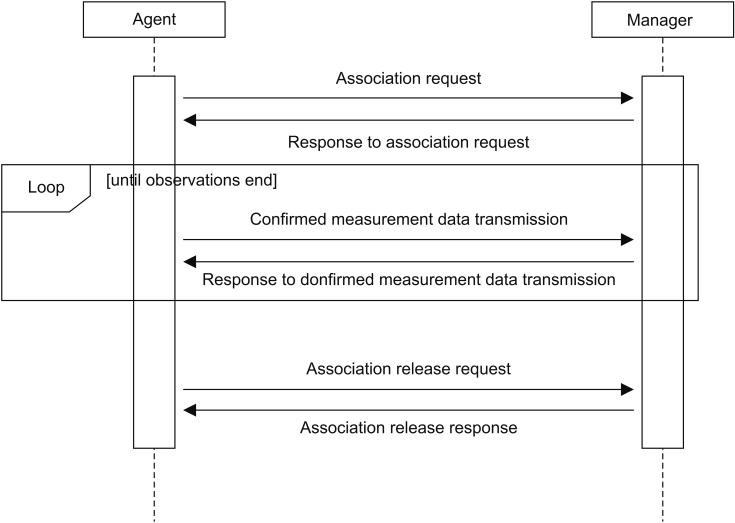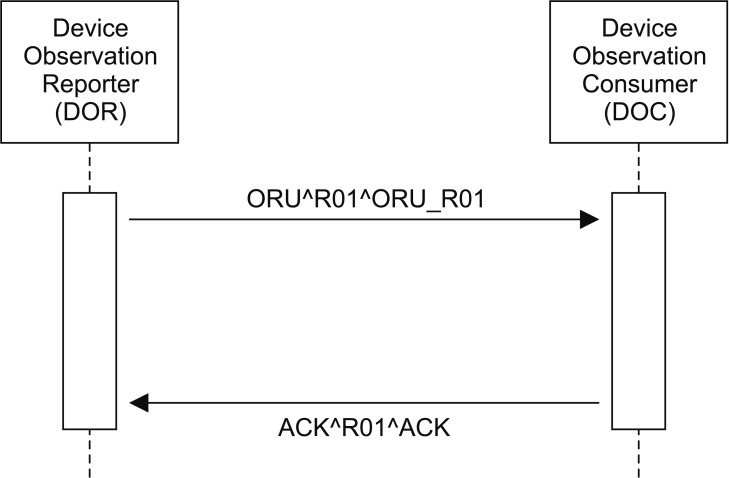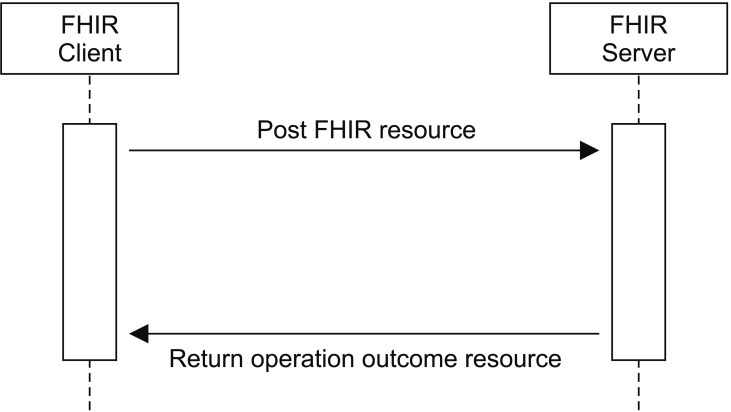Healthc Inform Res.
2018 Jan;24(1):46-52. 10.4258/hir.2018.24.1.46.
Comparison and Analysis of ISO/IEEE 11073, IHE PCD-01, and HL7 FHIR Messages for Personal Health Devices
- Affiliations
-
- 1School of Computer Science and Engineering, College of IT Engineering, Kyungpook National University, Daegu, Korea. sklee@knu.ac.kr
- KMID: 2403295
- DOI: http://doi.org/10.4258/hir.2018.24.1.46
Abstract
OBJECTIVES
Increasing use of medical devices outside of healthcare facilities inevitably requires connectivity and interoperability between medical devices and healthcare information systems. To this end, standards have been developed and used to provide interoperability between personal health devices (PHDs) and external systems. ISO/IEEE 11073 standards and IHE PCD-01 standard messages have been used the most in the exchange of observation data of health devices. Recently, transmitting observation data using the HL7 FHIR standard has been devised in the name of DoF (Devices on FHIR) and adopted very fast. We compare and analyze these standards and suggest that which standard will work best at the different environments of device usage.
METHODS
We generated each message/resource of the three standards for observed vital signs from blood pressure monitor and thermometer. Then, the size, the contents, and the exchange processes of these messages are compared and analyzed.
RESULTS
ISO/IEEE 11073 standard message has the smallest data size, but it has no ability to contain the key information, patient information. On the other hand, PCD-01 messages and FHIR standards have the fields for patient information. HL7 DoF standards provide reusing of information unit known as resource, and it is relatively easy to parse DoF messages since it uses widely known XML and JSON.
CONCLUSIONS
ISO/IEEE 11073 standards are suitable for devices having very small computing power. IHE PCD-01 and HL7 DoF messages can be used for the devices that need to be connected to hospital information systems that require patient information. When information reuse is frequent, DoF is advantageous over PCD-01.
Keyword
MeSH Terms
Figure
Cited by 1 articles
-
Association between Electronic Medical Record System Adoption and Healthcare Information Technology Infrastructure
Youn-Tae Lee, Young-Taek Park, Jae-Sung Park, Byoung-Kee Yi
Healthc Inform Res. 2018;24(4):327-334. doi: 10.4258/hir.2018.24.4.327.
Reference
-
1. Tang PC, Ash JS, Bates DW, Overhage JM, Sands DZ. Personal health records: definitions, benefits, and strategies for overcoming barriers to adoption. J Am Med Inform Assoc. 2006; 13(2):121–126. PMID: 16357345.
Article2. Do H, In J, Lee S. Implementation of ASN.1 converter for applying ISO/IEEE 11073 MDER. J Korean Inst Inf Technol. 2012; 10(4):19–30.3. Institute of Electrical and Electronics Engineers. IEEE Standard Computer Dictionary: a compilation of IEEE Standard Computer Glossaries 610. New York (NY): Institute of Electrical and Electronics Engineers;1991.4. International Organization for Standardization. Health informatics—Point-of-care medical device communication—Part 20101: Application profiles—Base standard. Geneva, Switzerland: International Organization for Standardization;2004. ISO/IEEE 11073-20101:2004.5. Yuksel M, Dogac A. Interoperability of medical device information and the clinical applications: an HL7 RMIM based on the ISO/IEEE 11073 DIM. IEEE Trans Inf Technol Biomed. 2011; 15(4):557–566. PMID: 21558061.
Article6. Integrating the Healthcare Enterprise [Internet]. Oak Brook (IL): IHE International;c2016. cited at 2018 Jan 10. Available from: http://www.ihe.net.7. Integrating the Healthcare Enterprise. IHE Patient Care Device (PCD) technical framework (volume 1) [Internet]. Oak Brook (IL): IHE International;c2017. cited at 2018 Jan 10. Available from: https://www.ihe.net/Technical_Frameworks/#pcd.8. W3C Recommendation. SOAP Version 1.2 Part 0: Primer (second edition) [Internet]. Cambridge (MA): World Wide Web Consortium;2007. cited at 2018 Jan 10. Available from: https://www.w3.org/TR/soap12-part0/.9. Spronk R. Transport Specification: MLLP, Release 1. Ann Arbor (MI): Health Level Seven International;2003.10. Health Level Seven International. FHIR Release 3 (STU) [Internet]. Ann Arbor (MI): Health Level Seven International;c2011. cited at 2018 Jan 10. Available from: https://www.hl7.org/fhir/.11. Fielding RT. Architectural styles and the design of network- based software architectures [dissertation]. Irvine (CA): University of California;2000.12. International Organization for Standardization. Health informatics—Personal health device communication—Part 10407: Device specialization—Blood pressure monitor. Geneva, Switzerland: International Organization for Standardization;2008. ISO/IEEE 11073-10407:2008.13. International Organization for Standardization. Health informatics—Personal health device communication—Part 10408: Device specialization—Thermometer. Geneva, Switzerland: International Organization for Standardization;2008. ISO/IEEE 11073-10408:2008.14. International Organization for Standardization. Health informatics—Personal health device communication—Part 20601: Application profile—Optimized exchange protocol. Geneva, Switzerland: International Organization for Standardization;2014. ISO/IEEE 11073-20601:2014.15. Health Level Seven International. HL7 Messaging Standard Version 2.6 [Internet]. Ann Arbor (MI): Health Level Seven International;2007. cited at 2018 Jan 10. Available from: http://www.hl7.org/implement/standards/product_brief.cfm?product_id=145.16. Rhoads JG, Cooper T, Fuchs K, Schluter P, Zambuto RP. Medical device interoperability and the Integrating the Healthcare Enterprise (IHE) initiative. Biomed Instrum Technol. 2010; (Suppl):21–27.17. Health Level Seven International. HL7 Version 3 Specification: hData Record Format, Release 1 [Internet]. Ann Arbor (MI): Health Level Seven International;2014. cited at 2018 Jan 10. Available from: http://www.hl7.org/implement/standards/product_brief.cfm?product_id=261.18. Dolin RH, Alschuler L, Behlen F, Biron PV, Boyer S, Essin D, et al. HL7 document patient record architecture: an XML document architecture based on a shared information model. Proc AMIA Symp. 1999; 52–56. PMID: 10566319.19. Clarke M, Bogia D, Hassing K, Steubesand L, Chan T, Ayyagari D. Developing a standard for personal health devices based on 11073. Conf Proc IEEE Eng Med Biol Soc. 2007; 2007:6175–6177. PMID: 18003430.
Article20. Clark J, Pieters S, Thompson HS. Associating stylesheets with XML documents 1.0 (second edition). Cambridge (MA): World Wide Web Consortium;2010.
- Full Text Links
- Actions
-
Cited
- CITED
-
- Close
- Share
- Similar articles
-
- Development of Cell Phone Application for Blood Glucose Self-Monitoring Based on ISO/IEEE 11073 and HL7 CCD
- The Development of a Graphical User Interface Engine for the Convenient Use of the HL7 Version 2.x Interface Engine
- Introduction of the Communication Standard Health Level Seven and HL7 Korea
- Evolving Software Architecture Design in Telemedicine: A PRISMA-based Systematic Review
- Design and Evaluation of a Prototype HL7 Message Server for Data Sharing across and within Medical Institutions




